Faces Of Time: An Introduction To Materials Used In The Art Of The Dial
Beauty is more than skin deep, but it’s not a bad place to start.
It is a truism in the watch business that to sell a watch, all you have to do is sell the dial and while it’s a truism, not a truth, there is like most truisms, some truth to it. The dial is the first thing you see when you look at a watch (I’m sure there are people who look at the movement first if it’s there to look at and I might be one of them) and while a great movement and great case can help make a watch, a sub-par dial, poorly laid out, or haphazardly or thoughtlessly designed or poorly executed, can absolutely destroy any potential appeal an otherwise excellent watch could have. The dial, despite the preoccupation so many of us have with other aspects of the watch, has more potential to be make-or-break than any other aspect of a timepiece, and in the five hundred or so years that watchmaking has been evolving, the dial has been evolving as well.
The Basics: Telling The Time
The most fundamental purpose of a dial is to enable the owner of a watch to read the time, but you can get by with surprisingly little and still have a legible watch. One of the great things about analog timekeeping is that once you train yourself to read the time from the relative positions of the hour and minute hands, you don’t need a whole lot on the dial to orient yourself. The best example of this is the Movado Museum watch, which was designed by Nathan George Horwitt in 1947; the dial is all black, with a gold circle at 12:00. You can read the time with surprising accuracy but generally speaking, we all seem to need a little more help than that, especially when setting a watch and so we have the almost infinite range of watch dials on the market today, where usually, there are markers for hours, minutes, and seconds.
Design aside, the construction of most modern watch dials begins with a disk of metal, usually brass – gold and silver are also used as well although less frequently. The brass disk usually has two dial feet welded to its underside, which fit into apertures on the top of the movement and which are fixed in place by small clamps. Dials are usually coated with several layers of paint, and then treated with a clear lacquer coat to prolong the life of the dial and reduce oxidation and discoloration.
Enamel Dials: Born In Fire
Enamel dials are made by coating the dial blank with a thin layer of powdered pigment, usually in the form of colored glass, which has been ground to a fine powder. Traditionally, grinding the powder is done by hand, and the texture of the powder and even the sound it makes as it’s being ground, are judged by the enamelist as a way of determining when the enamel is ready to apply. The powder is usually mixed with a liquid medium – water or oil – to form a slurry which is then applied to the dial base. The dial is then fired in a kiln, which is hot enough to evaporate the liquid and also to cause the powder to fuse together into a single solid surface.
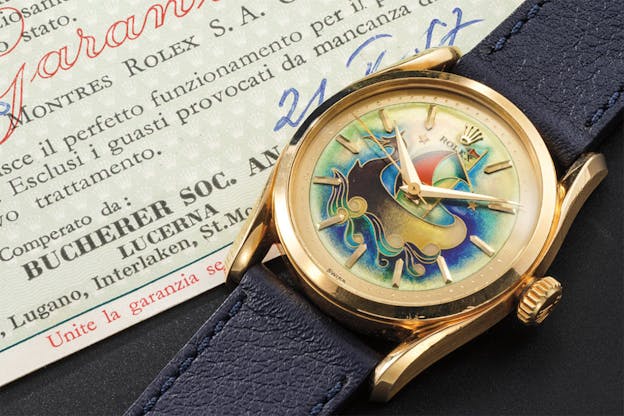
The simplest enamel dials are one uniform color across the dial, but much more complex enamel dials can be produced. Different colors can be used to create really impressive miniature effects. One of the most popular enameling techniques is cloisonné, in which “cloisons” (partitions) are created using flat gold wire bent into various shapes. The individual cells are then filled with different color enamels and very beautiful patterns, sometimes with gradient effects, can be created. Champlevé is another technique – in champlevé enameling, shallow hollows are engraved into the dial surface, which are then filled with enamel and fired. Another rare and very difficult technique is paillonnée enameling, in which tiny decorative gold spangles are cut from gold foil, placed on enamel, and fired to fix them in position; the paillons are so delicate that they have to be positioned with an artist’s brush (touching them with your fingers would destroy them).
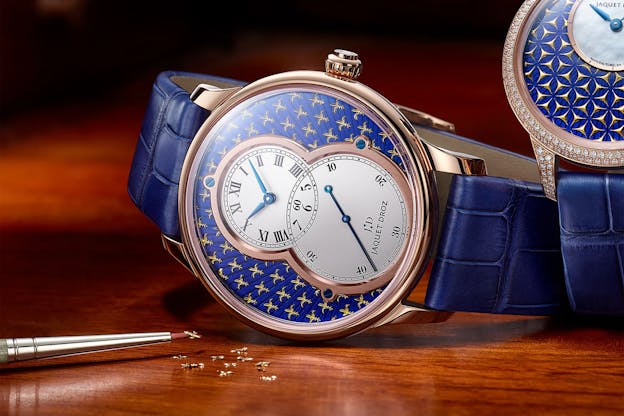
The most sophisticated and difficult of enameling techniques, is enamel miniature painting. Here, representational scenes, which are often miniature versions of masterpieces of representational art, are painted onto the dial. The technique is extremely time consuming and requires great skill and experience, since the colors of different enamels can interact in unpredictable ways and colors may change during the firing process. Top tier enamelists specializing in enamel miniatures include Suzanne Rohr, now retired but formerly at Patek Philippe, and Anita Porchet, who is one of a generation of pioneering enamelists who kept the art alive when it was in danger of dying out completely in the late 1990s.
Gem Set Dials: All That Glitters
There is a little bit of a tendency among watch enthusiasts to disparage gem set dials in particular, and gem set watches in general, as mere bling for bling’s sake but as with everything else in horology, it’s at least as much about how you do what you do as it is about what it is you do in the first place. It is certainly true that there are watches (and jewelry) out there which are made with stones of dubious quality, poorly set into almost entirely undistinguished watches – well, let us say entirely undistinguished. It is also true, however, that at a high level horological gem set dials represent an enormous challenge as well as an exercise of craft unlike anything else in watchmaking.

All of the qualities of precious stones that factor into assessing the quality of jewelry also apply to horological gem setting, including the famous four Cs of Cut, Color, Carat (weight) and Clarity, but horological gem setting is in some respects even more demanding than jewelry making. Gem setting generally involves creating a metal receptacle of some sort for each stone, and then bending the metal around the stone to hold it in place.

One of the biggest challenges with watch dials, is that generally there’s less light passing through the stone than if it were set into a ring, necklace, or brooch, and so for diamonds (for instance) stones have to be selected, cut, and set so as to maximize light transmission and the “fire” that makes diamonds so beautiful to look at. Whether clear or colored, stones have to be chose to match as closely as possible, since any difference in color and saturation will be instantly visible to the naked eye. Color matching can sometimes mean discarding up to 90 per cent of a gem quality stone just to get the desired color match.

One of the most demanding forms of horological gem setting is snow setting, which was originally developed at Jaeger-LeCoultre and introduced in 2002. Snow setting as the name implies, is the setting of stones of varying sizes – from as small as 0.5mm to 1.5mm and larger – in a pattern which looks like fallen snow. The technique requires an individual aperture to be cut for each individual stone, and the size of each aperture has to exactly match the different stone sizes. The stones must also be set as close to each other as possible, and that’s extremely close – even under magnification, it’s hard to see any metal between the stones on a snow set watch dial.
Marquetry Dials: Art Of The Mosaic
Marquetry consists of a group of techniques for making abstract or representational patterns on a flat surface, by cutting material into different shapes and colors and matching them together. In a story for Revolution on the subject, editor Cheryl Chia mentions that the Renaissance painter, architect, and author Giorgio Vasari said that marquetry requires “more patience than skill” but you look at something like the Farnese Table and you have to wonder if Vasari didn’t have some axe to grind.
Marquetry dial watches are rare and usually, quite expensive for the same reason that minute repeaters are rare and expensive – the techniques require years of training, a high degree of manual skill, artistic good taste (in visual composition for marquetry dials; in tone and musicality for repeaters) and the production process does not scale.

Marquetry dials can be made of colored minerals, but they can also be made of stained and cut wood, and even natural materials like leather, straw, and feathers. Each material presents its own unique challenges, and potential for artistic expression – feather dials, for instance, require careful selection and preparation.
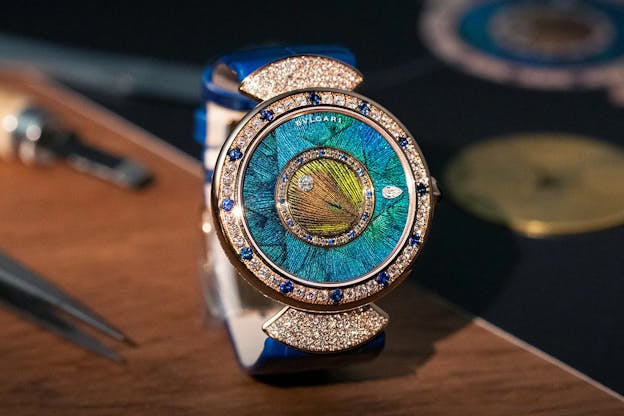
Feathers must be ethically sourced; and before being made into marquetry, each feather is washed and disinfected, tinted, and ironed into shape, before being cut into the marquetry pattern.
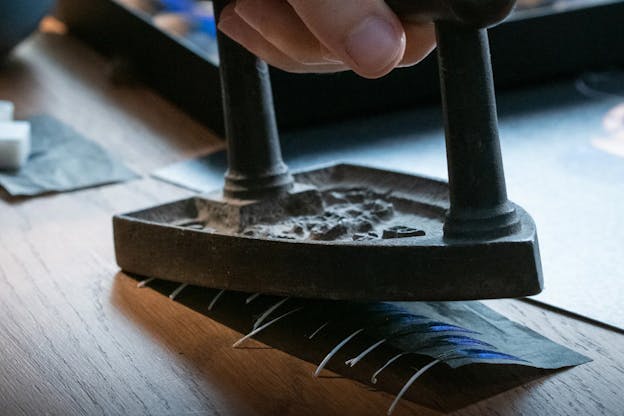
Wood marquetry can produce extremely finely detailed images, as can can straw, and stone marquetry has a unique depth and luster. Thanks to the variations which exist in natural materials, as well as the amount of skill and time involved in making them, marquetry watches are usually unique pieces.
Stone Dials: Beauty From The Underworld
Unlike marquetry dials, stone dials can be made in series, but as with marquetry, natural variations in materials can make every watch unique to some degree. Stone dial watches are exactly that – watches made with dials formed from thinly cut disks of semiprecious stones. Jade, onyx, lapis lazuli, malachite, and jasper are just a few of the materials that can be used for stone dials (which are also often called hardstone dials).
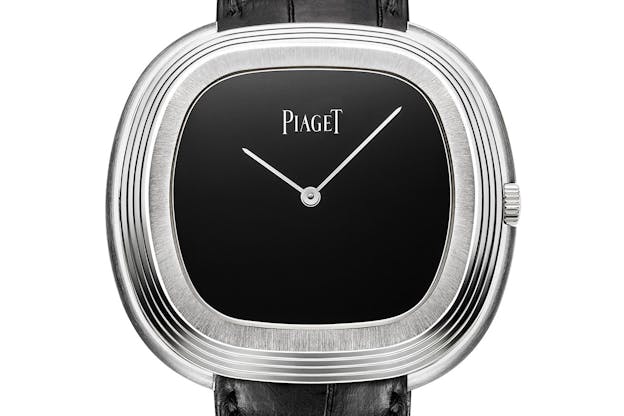
The big technical challenge with stone dials is the thinness it’s necessary to achieve while cutting and shaping the dial. Although the minerals chosen are notable for their beauty, the thinner they’re cut, the more fragile they become. Losses from breakage still occur during production today, and especially during the period in the 1960s, when Piaget was making hardstone dial watches part of the larger vocabulary of horology, the loss rate was even higher. Placing dial markers, or creating openings for day or date windows, also increases the risk of damage. However, the depth and range of colors you can get with hardstone dials can’t be duplicated by other techniques, not even enameling.
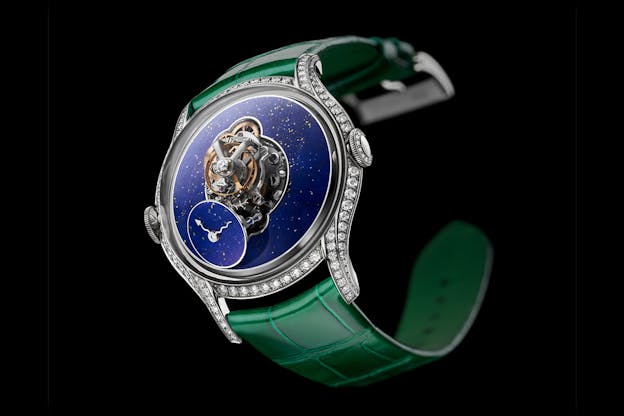
Mother of pearl is not usually classified as a mineral dial material, but it is in fact, at least partly a mineral material – a form of calcium carbonate, called aragonite, which in mother of pearl is arranged in geometrically ordered stacks held together by an organic matrix composed of a number of proteins, including chitin (the same stuff your fingernails are made of) and lustrin, which acts as a shock absorber. The same caveats apply to MOP as to other mineral dials in terms of fragility and risk of damage during fabrication, albeit in a different way – MOP is much harder to break, although it is softer than hardstones and easier to scratch. It’s a very versatile material as well – it can be engraved and even decorated with guilloché.

Another somewhat crossover material is aventurine. The term can refer either to a type of decorative glass created in Murano, in Venice, which has been the world capital of decorative glassmaking for centuries. It can also refer to a naturally occurring mineral that has similar optical properties, but in this case, the name of the glass preceded the naming of the mineral.
Meteorite Dials: The Dials That Fell To Earth
Meteorite dials are a type of mineral dials, of course, but the material is different enough from any other mineral to deserve its own category. The first and most obvious difference between meteorite and other minerals, is that meteorites aren’t from around here. There are many possible sources for meteors, including chunks of rock that have been knocked loose from the Moon or Mars, but most come from asteroids or other stony fragments which formed during the formation of the Solar System, around four and a half billion years ago. Many meteorite dials are made specifically from iron-nickel meteorites.
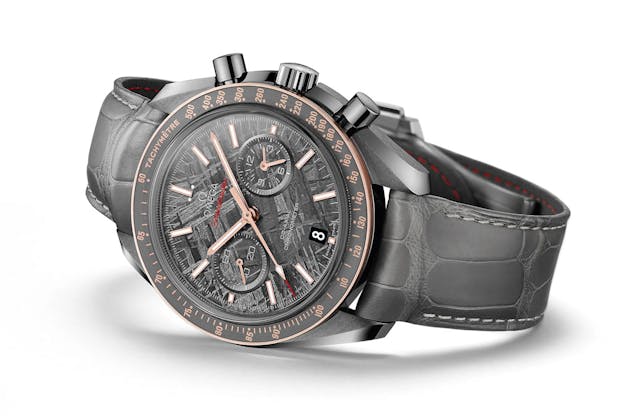
While iron-nickel meteorites are much less common than stony meteorites, they are much more widely represented in watchmaking, partly thanks to the fact that iron-nickel meteorites are much more resistant to weathering. Meteorite dials are made by cutting disks out of the raw material, and then acid-etching the disk to reveal the interior crystal structure, which consists of interlocking geometric patterns called Widmanstätten patterns, named for the Viennese scientist who discovered them in 1808 (they are also called Thompson patterns, after the British mineralogist who may have observed them before his Viennese counterpart.
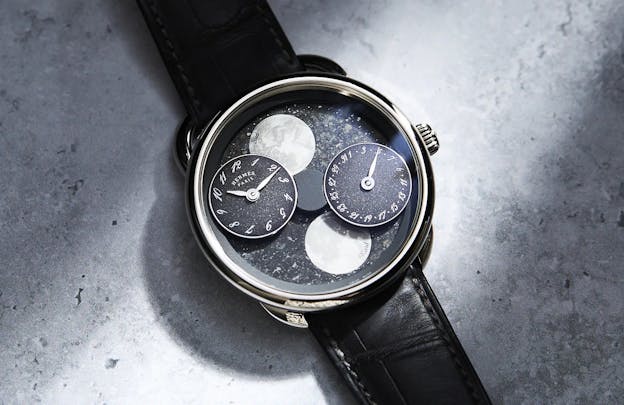
The crystals are essentially extremely large single crystals of iron, and this is what makes meteorite dials impossible to duplicate. Such crystals grow extremely slowly, and can take many millions of years to form; they can get that big in the cooling molten cores of asteroids, which cool extremely slowly. Unless you’re willing to wait about thirty million years, the only place you’ll find iron crystals this big, is in meteorites.
Mix And Match
Each of these dial materials and methods can be used alone, but often, in order to create particular effects, they’re combined with others.

The Louis Vuitton “Dragon’s Cloud” is an example of combining a variety of materials and techniques. Here, damascening, or inlaying one metal into another of a different color, is used to create part of the background, and champlevé enameling is used for part of the dragons body, as well as the monogram (the signature of Gaston-Louis Vuitton, whose collections inspired the Cabinet of Wonders watch trilogy of which the Dragon’s cloud is a part). The lower part of the dragon’s body is done in paillonnée enamel.
Over the last century, watchmaking has incorporated a constantly expanding repertoire of materials in dial-making. Synthetic sapphire, for instance, has made it possible to produce multi-layered dials with astonishing visual properties – the best known maker of such dials is probably MING, whose dials are sometimes made up of several distinct layers of sapphire treated with different techniques, including the Mosaic dials, the most complex of which has 3,300 individual laser-etched elements. This is an example of the degree to which modern technology has made it possible to create visual effects which would have been impossible even a few decades ago.

There are always more and more exotic and unusual materials finding their way into the making of watch dials as well – in 2012, for instance, Girard Perregaux created a watch with a dial made of concrete, of all things, to honor the architect Le Corbusier, whose work made extensive use of the material. Unusual dial materials and decorative techniques, created in an almost infinite variety, have increasingly become a major and even essential element in the identities of modern watch brands – a trend that shows no signs of slowing down.
Frequently Asked Questions About Watch Dial Materials
- What is the most common base material for watch dials?
Most modern watch dials start with a brass disk, though gold and silver are also used less frequently. The brass base typically has dial feet welded underneath for mounting. - How are enamel dials made?
Enamel dials are made by applying finely ground colored glass to a metal surface and firing it in a kiln. Techniques include cloisonné, champlevé, paillonnée, and miniature painting. - What are the challenges of making gem-set dials?
Gem-set dials require high precision due to limited light and small surface area. Stones must be color-matched, and techniques like snow setting demand exact aperture sizing for each stone. - What is marquetry in watch dials?
Marquetry involves arranging cut pieces of wood, straw, feathers, or stone into patterns or images. Each material must be carefully prepared, cut, and placed by hand. - Why are stone dials considered unique?
Stone dials, such as those made from jade, onyx, or lapis lazuli, are fragile and each one features natural variations. Cutting them thin enough for watch dials is technically challenging. - How are meteorite dials different from other mineral dials?
Meteorite dials are cut from iron-nickel meteorites and etched to reveal Widmanstätten patterns. These crystals form over millions of years and can’t be artificially replicated. - Can dialmaking techniques be combined?
Yes, many high-end watches combine techniques like damascening with champlevé and paillonnée enameling to create multi-material, multi-layered artistic designs. - What role does synthetic sapphire play in modern dials?
Synthetic sapphire enables layered dial construction and optical effects, as seen in MING’s mosaic dials, which feature laser etching and luminous elements across multiple sapphire layers.

